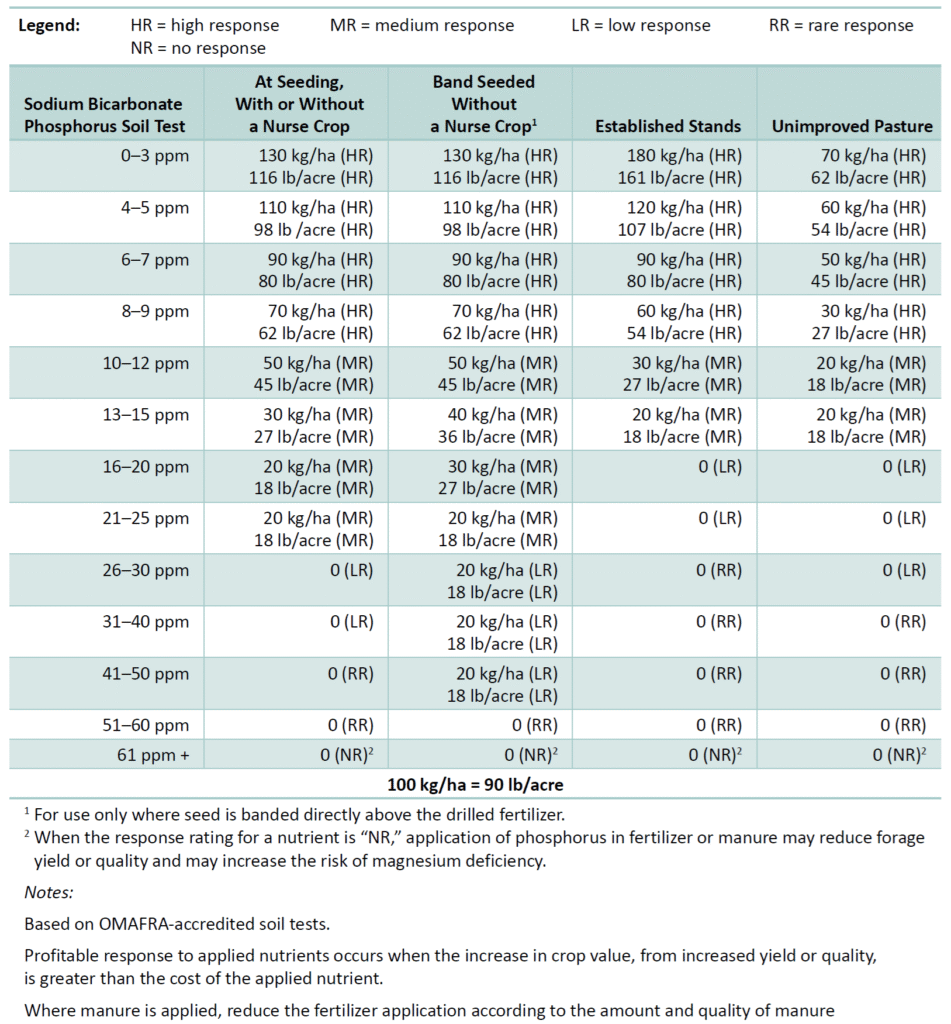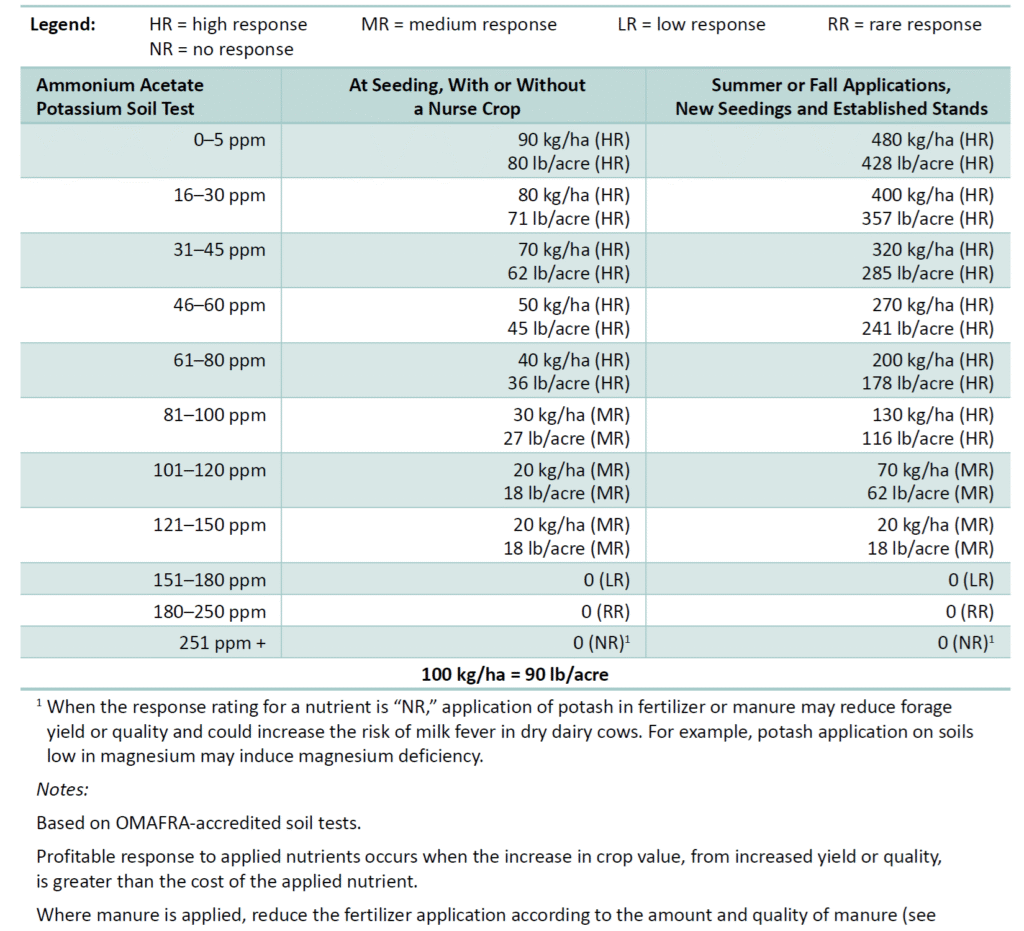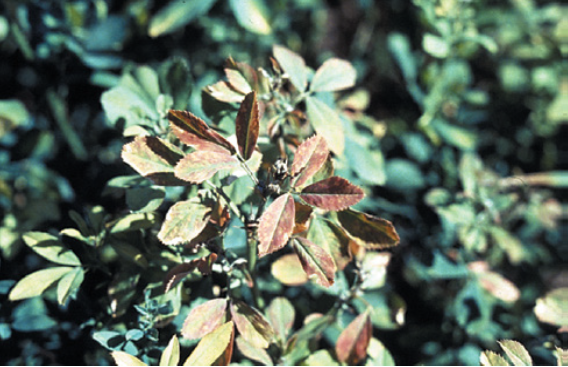Alfalfa has high fertility requirements (Table 1). Because the entire above-ground biomass is removed at harvest, and this plant material is still green, soil nutrient draw-down can be very rapid. Alfalfa growers may wish to soil test annually to ensure the crop is getting enough nutrients.
| One Production Year (3 cuts) | Lifetime (10 cuts) | |||
| Metric | Imperial | Metric | Imperial | |
| Yield | 7.78 tonnes DM/ha | 3.47 tons DM/acre | 25.34 tonnes DM/ha | 11.30 tons DM/acre |
| Nitrogen Removal | 244 kg/ha | 218 lb/acre | 793 kg/ha | 708 lb/acre |
| Phosphate Removal | 50 kg/ha | 45 lb/acre | 164 kg/ha | 146 lb/acre |
| Potash Removal | 233 kg/ha | 208 lb/acre | 758 kg/ha | 676 lb/acre |
Phosphate and Potash
Phosphate (P2O5) and potash (K2O) guidelines are given in Table 2 and Table 3. These guidelines are based on OMAFRA-accredited soil tests using the sufficiency approach, which applies the most economic rate of nutrients for a given crop year. For information on the use of these tables or if an OMAFRA-accredited soil test is unavailable, see OMAFRA Publication 811, Agronomy Guide for Field Crops.
When direct-seeding on soils that require phosphate fertilizer, establishment may be improved by the placement of a high phosphate fertilizer 5 cm (2 in.) directly below the seed. Using a grain drill with fertilizer and grass seed attachments, this placement may be accomplished by drilling the fertilizer through the furrow opener and dropping the forage seed on a firm soil surface directly behind the furrow opener. Usually it is advisable to firm the soil surface immediately after seeding.
Phosphate, if required, may be applied with the potash or at other times of the year. Phosphate deficiency symptoms are rare and non-specific in forages, but a shortage of phosphate may manifest itself as stunting and poor winter survival of legumes.

Potash may be more effective in promoting persistence if it is applied within the 6 weeks before the start of the fall rest period. Severe potash deficiency is visible in alfalfa with symptoms of small, light dots on the leaflets. These dots can be on any part of the leaflet but are usually concentrated near the margins (Figure 1). Potash deficiency results in overall slow growth and poor yield.

High soil potassium levels can result in luxury consumption of potassium by forages and subsequent nutritional problems when fed to dairy cows prior to calving. Potassium applications on soils testing over 150 ppm will not significantly increase winter hardiness and are not recommended.

Sulphur
Sulphur (S) deficiency is being observed more frequently on alfalfa in Ontario with significant reductions in yield. The appearance of sulphur deficiency is similar to nitrogen deficiency with general yellowing of the plants (Figure 2). Sulphur availability varies from year to year according to temperature and rainfall. Sulphur, like nitrogen, can be leached below the root zone. Sulphur in manure is in the elemental form, which is more slowly available than sulphate fertilizers.

Sulphur deficiencies are more likely to occur in Northwestern Ontario, (where soil is upwind of major industrial centres) on low organic matter soils, and soils that have not had a manure application for several years. Tissue sampling of alfalfa is a diagnostic tool used to predict whether there will be a response to applying S (see Table 3-3). If required, apply 6 kg/ha of S per tonne (5 lb/acre of S/ton) of expected dry matter yield. Sulphur must be in the sulphate form to be utilized by plants, so application of sulphate-S provides a more immediate yield response. Applying elemental-S bulk, blended with other fertilizer, is a cost-effective long-term method of providing S.

Boron
Boron (B) is important for alfalfa, but application is not required on all soils. A deficiency shows up mainly on high-pH, sandy soils. Boron applications are often advised on sandy soils and, in particular, the sandy loam and loam soils in the area east of the Niagara Escarpment up to and including Frontenac County. Boron deficiency is seen most frequently on droughty soils under dry conditions.
As boron deficiency becomes more visual, the youngest upper leaves of the plant become yellow to red in different plants (Figure 3). Growth can be severely stunted and winter hardiness reduced. Boron deficiency can usually be corrected or prevented by an application of 1.0–2.0 kg/ha (0.9–1.8 lb/acre) of boron broadcast with the other fertilizer (e.g., potash). Boron should not be banded at seeding.
